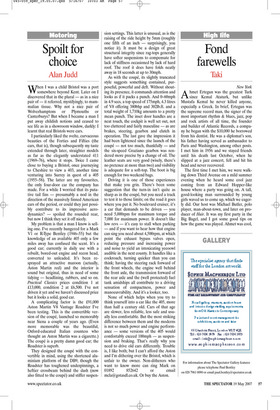Spoilt for choice
Alan Judd
When I was a child Bristol was a port somewhere beyond Kent. Later on I discovered that in the plural — as in a nice pair of — it referred, mystifyingly, to mammalian tissue. Why not a nice pair of Wolverhamptons or Plymouths or Canterburys? But when I became a man I put away childish notions and ceased to see life as in a showroom window, darkly: I learnt that real Bristols were cars.
I particularly liked the svelte, curvaceous beauties of the Forties and Fifties (the cars, that is), though subsequently my taste extended through later, straighter models as far as the elegantly understated 411 (1969–76), where it stops. Twice I came close to buying a Bristol, once journeying to Cheshire to view a 403, another time venturing into Surrey in quest of a 405 (1955–58). The latter are my favourites, the only four-door car the company has made. For a while I worried that its putative tail fins — presumably a nod in the direction of the massively finned American cars of the period, or could they just possibly contribute to its impressive aerodynamics? — spoiled the rounded rear, but now I think they set it off nicely.
My problem is that a man I know is selling one. I’ve recently hungered for a Mark V1 or R-Type Bentley (1946–55) but the knowledge of an available 405 only a few miles away has confused the scent. It’s a good car; currently in daily use with a rebuilt, bored-out engine and recon head, converted to unleaded. It’s been resprayed an attractive maroon (actually, Aston Martin red) and the interior is sound but original, thus in need of some tidying — headlining, rubbers, and so on. Practical Classics prices condition 1 at £13,000, condition 2 at £6,500. I’ve not driven it yet and we haven’t discussed price but it looks a solid, good car.
A complicating factor is the £91,000 Aston Martin V8 Vantage Roadster I’ve been testing. This is the convertible version of the coupé, launched so memorably near Siena a couple of years ago. (Even more memorable was the beautiful, Oxford-educated Italian countess who thought an Aston Martin was a cigarette.) The coupé is a pretty damn good car; the Roadster is superb.
They designed the coupé with the convertible in mind, using the shortened aluminium platform of the DB9, though the Roadster has toughened underpinnings, a heftier crossbeam behind the dash (now also fitted to the coupé) and stiffer suspen sion settings. This latter is unusual, as is the raising of the ride height by 5mm (roughly one fifth of an inch — surprisingly, you notice it). It must be a design of great structural integrity since rag-tops generally have softer suspensions to compensate for lack of stiffness occasioned by lack of hard roof. The roof it does have folds neatly away in 18 seconds at up to 30mph.
As with the coupé, its slightly truncated style suggests something contained, purposeful, powerful and deft. Without shouting its presence, it commands attention and looks as if it packs a punch. And 0–60mph in 4.9 secs, a top speed of 175mph, 4.3 litres of V8 offering 380bhp and 302lb.ft. and a total weight of 1,710kg amounts to a pretty mean punch. The inset door handles are a neat touch, the cockpit is well set out, not too cluttered and fairly masculine — as are brakes, steering, gearbox and clutch in operation. The last gave the impression it had been lightened since the launch of the coupé — not too much, thankfully — and the six-speed Graziano gearbox was rendered more precise by a change of oil. The leather seats are very good (wisely, there’s no pretence at more than two) and visibility is adequate for a soft-top. The boot is big enough for two weekend bags.
Driving it is one of those experiences that make you grin. There’s been some suggestion that the turn-in isn’t quite as sharp as in the coupé, but you need a track to test it to those limits; on the road it goes where you put it. No boulevard cruiser, it’s a car that demands to be driven — you need 5,000rpm for maximum torque and 7,000 for maximum power. It doesn’t like low revs — it’s easy to stall when parking — and if you want to hear how that engine can sing you need about 4,500rpm, at which point the exhaust bypass valves open, reducing pressure and increasing power and noise to yield an intoxicating yeeoowl audible in the next county. It handles like a cockroach, turning quicker than you can think; having the steering rack forward of the front wheels, the engine well behind the front axle, the transmission forward of the rear axle and the (well protected) fuel tank amidships all contribute to a driving sensation of compactness, power and manoeuvrability. And it’s a looker, too.
None of which helps when you try to think yourself into a car like the 405, more than half a century old. Cars of that age are slower, less reliable, less safe and usually less comfortable. But the most striking difference between them and the moderns is not so much power and engine performance — some versions of the 405 would comfortably exceed 100mph — as suspension and braking. That’s really why you need to drive old cars differently. Trouble is, I like both; but I can’t afford the Aston and I’m dithering over the Bristol, which is unfair to the owner. Non-ditherers who want to know more can ring Mark on 01892 852642 or email mcla@gotasdl.co.uk. Or buy the Aston.










































































 Previous page
Previous page